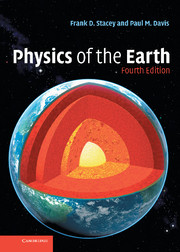Book contents
- Frontmatter
- Contents
- Preface
- 1 Origin and history of the Solar System
- 2 Composition of the Earth
- 3 Radioactivity, isotopes and dating
- 4 Isotopic clues to the age and origin of the Solar System
- 5 Evidence of the Earth's evolutionary history
- 6 Rotation, figure of the Earth and gravity
- 7 Precession, wobble and rotational irregularities
- 8 Tides and the evolution of the lunar orbit
- 9 The satellite geoid, isostasy, post-glacial rebound and mantle viscosity
- 10 Elastic and inelastic properties
- 11 Deformation of the crust: rock mechanics
- 12 Tectonics
- 13 Convective and tectonic stresses
- 14 Kinematics of the earthquake process
- 15 Earthquake dynamics
- 16 Seismic wave propagation
- 17 Seismological determination of Earth structure
- 18 Finite strain and high-pressure equations of state
- 19 Thermal properties
- 20 The surface heat flux
- 21 The global energy budget
- 22 Thermodynamics of convection
- 23 Thermal history
- 24 The geomagnetic field
- 25 Rock magnetism and paleomagnetism
- 26 ‘Alternative’ energy sources and natural climate variations: some geophysical background
- Appendix A General reference data
- Appendix B Orbital dynamics (Kepler's laws)
- Appendix C Spherical harmonic functions
- Appendix D Relationships between elastic moduli of an isotropic solid
- Appendix E Thermodynamic parameters and derivative relationships
- Appendix F An Earth model: mechanical properties
- Appendix G A thermal model of the Earth
- Appendix H Radioactive isotopes
- Appendix I A geologic time scale
- Appendix J Problems
- References
- Name Index
- Subject Index
17 - Seismological determination of Earth structure
Published online by Cambridge University Press: 05 July 2013
- Frontmatter
- Contents
- Preface
- 1 Origin and history of the Solar System
- 2 Composition of the Earth
- 3 Radioactivity, isotopes and dating
- 4 Isotopic clues to the age and origin of the Solar System
- 5 Evidence of the Earth's evolutionary history
- 6 Rotation, figure of the Earth and gravity
- 7 Precession, wobble and rotational irregularities
- 8 Tides and the evolution of the lunar orbit
- 9 The satellite geoid, isostasy, post-glacial rebound and mantle viscosity
- 10 Elastic and inelastic properties
- 11 Deformation of the crust: rock mechanics
- 12 Tectonics
- 13 Convective and tectonic stresses
- 14 Kinematics of the earthquake process
- 15 Earthquake dynamics
- 16 Seismic wave propagation
- 17 Seismological determination of Earth structure
- 18 Finite strain and high-pressure equations of state
- 19 Thermal properties
- 20 The surface heat flux
- 21 The global energy budget
- 22 Thermodynamics of convection
- 23 Thermal history
- 24 The geomagnetic field
- 25 Rock magnetism and paleomagnetism
- 26 ‘Alternative’ energy sources and natural climate variations: some geophysical background
- Appendix A General reference data
- Appendix B Orbital dynamics (Kepler's laws)
- Appendix C Spherical harmonic functions
- Appendix D Relationships between elastic moduli of an isotropic solid
- Appendix E Thermodynamic parameters and derivative relationships
- Appendix F An Earth model: mechanical properties
- Appendix G A thermal model of the Earth
- Appendix H Radioactive isotopes
- Appendix I A geologic time scale
- Appendix J Problems
- References
- Name Index
- Subject Index
Summary
Preamble
Our knowledge of the Earth's internal structure would almost certainly be very primitive if there were no earthquakes. Explosive sources of elastic waves would have been recognized and it is possible that exploration seismology, directed to the identification of oil-bearing structures in the crust, would have been well developed, but it is likely that deep-Earth seismology would have been rudimentary. The larger nuclear weapons tests generate waves of sufficient amplitudes to be detected at remote stations, but recognition of the test-monitoring possibilities of seismology depended on the fact that the subject was already well developed when nuclear testing began. Even if the weapons-testing agencies had appreciated the seismic detection possibilities, a shroud of secrecy would have ensured that evidence of deep Earth structure emerged only very slowly.
This hypothetical situation emphasizes how completely our detailed knowledge of the deeper parts of the Earth relies on observations of seismic waves. Quantitative instrumental data on teleseismic waves (from distant earthquakes) were first obtained in the late nineteenth century and, as the theory of elastic waves was then already well established, seismology developed rapidly. The use of earthquake-generated waves to study the Earth's interior is a mature and sophisticated science, to which this chapter is necessarily only a brief introduction. Comprehensive treatments are by Bullen and Bolt (1985), Aki and Richards (2002) and Stein and Wysession (2003).
As we now know, the Earth's internal layers, as well as the surface, are close to oblate ellipsoids, symmetrical about the rotational axis.
- Type
- Chapter
- Information
- Physics of the Earth , pp. 267 - 293Publisher: Cambridge University PressPrint publication year: 2008



